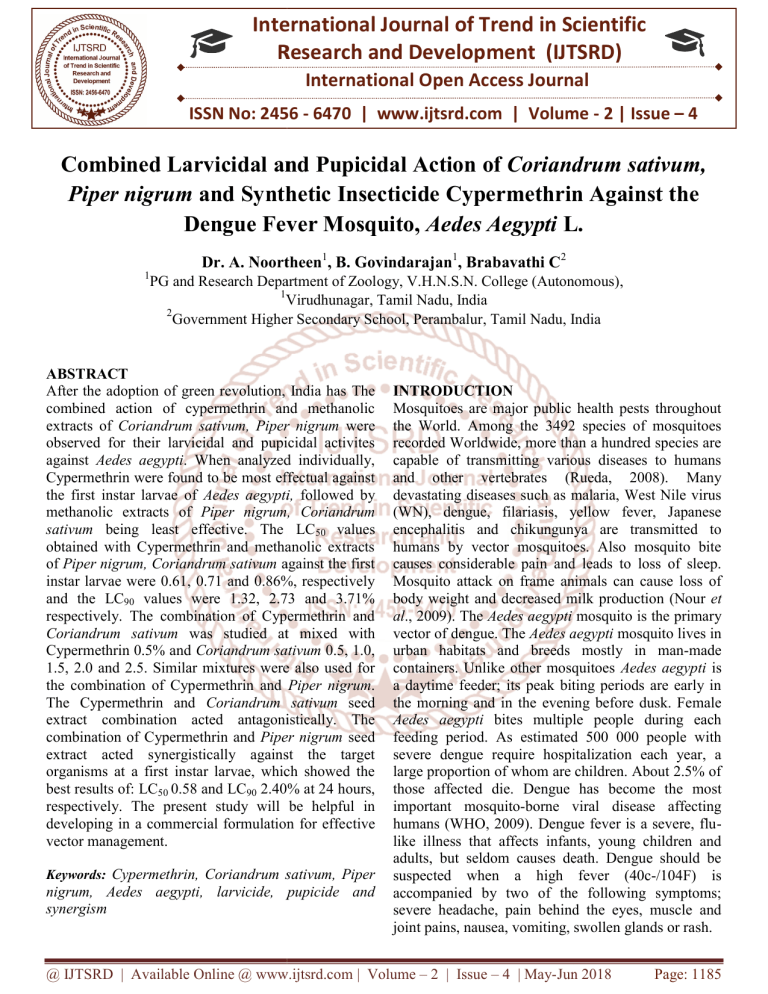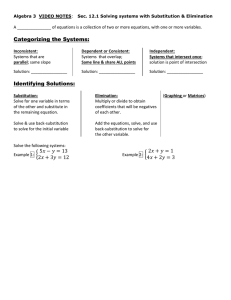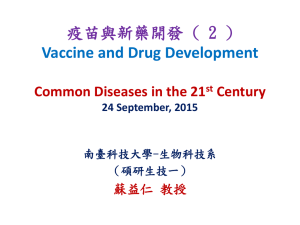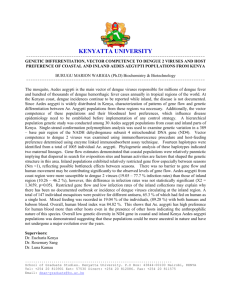
International Journal of Trend in Scientific
Research and Development (IJTSRD)
International Open Access Journal
ISSN No: 2456 - 6470 | www.ijtsrd.com | Volume - 2 | Issue – 4
Combined Larvicidal and Pupicidal Action oof Coriandrum sativum,
Piper nigrum and
nd Synthetic Insecticide Cypermethrin Against the
Dengue Fever Mosquito, Aedes Aegypti L.
1
Dr. A. Noortheen1, B. Govindarajan1, Brabavathi C2
PG and Research Department of Zool
Zoology,
ogy, V.H.N.S.N. College (Autonomous),
(Autonomous)
1
Virudhunagar
Virudhunagar, Tamil Nadu, India
2
Government Higher Secondary School, Perambalur
Perambalur, Tamil Nadu,, India
ABSTRACT
After the adoption of green revolution, India has The
combined action of cypermethrin and methanolic
extracts of Coriandrum sativum, Piper nigrum were
observed for their larvicidal and pupicidal activites
against Aedes aegypti.. When analyzed individually,
Cypermethrin were found to be most
ost effectual against
the first instar larvae of Aedes aegypti, followed by
methanolic extracts of Piper nigrum, Coriandrum
sativum being least effective. The LC 50 values
obtained with Cypermethrin and methanolic extracts
of Piper nigrum, Coriandrum sativum against the first
instar larvae were 0.61, 0.71 and 0.86%, respectively
and the LC90 values were 1.32, 2.73 and 3.71%
respectively. The combination of Cypermethrin and
Coriandrum sativum was studied at mixed with
Cypermethrin 0.5% and Coriandrum sativum 0.5, 1.0,
1.5, 2.0 and 2.5. Similar mixtures were also used for
the combination of Cypermethrin and Piper nigrum.
The Cypermethrin and Coriandrum sativum seed
extract combination acted antagonistically. The
combination of Cypermethrin and Piper nigrum seed
extract acted synergistically against the target
organisms at a first instar larvae, which showed the
best results of: LC50 0.58 and LC90 2.40% at 24 hours,
respectively. The present study will be helpful in
developing in a commercial formulation for effe
effective
vector management.
Keywords: Cypermethrin, Coriandrum sativum, Piper
nigrum, Aedes aegypti, larvicide, pupicide and
synergism
INTRODUCTION
Mosquitoes are major public health pests throughout
the World. Among the 3492 species of mosquitoes
recorded
ecorded Worldwide, more than a hundred species are
capable of transmitting various diseases to humans
and other vertebrates (Rueda, 2008). Many
devastating diseases such as malaria, West Nile virus
(WN), dengue, filariasis, yellow fever, Japanese
encephalitis
tis and chikungunya are transmitted to
humans by vector mosquitoes. Also mosquito bite
causes considerable pain and leads to loss of sleep.
Mosquito attack on frame animals can cause loss of
body weight and decreased milk production (Nour et
al., 2009). The Aedes aegypti mosquito is the primary
vector of dengue. The Aedes aegypti mosquito lives in
urban habitats and breeds mostly in man-made
man
containers. Unlike other mosquitoes Aedes aegypti is
a daytime feeder; its peak biting periods are early in
the morning
ng and in the evening before dusk. Female
Aedes aegypti bites multiple people during each
feeding period. As estimated 500 000 people with
severe dengue require hospitalization each year, a
large proportion of whom are children. About 2.5% of
those affected
d die. Dengue has become the most
important mosquito-borne
borne viral disease affecting
humans (WHO, 2009). Dengue fever is a severe, fluflu
like illness that affects infants, young children and
adults, but seldom causes death. Dengue should be
suspected when a high
gh fever (40c-/104F)
(40c
is
accompanied by two of the following symptoms;
severe headache, pain behind the eyes, muscle and
joint pains, nausea, vomiting, swollen glands or rash.
@ IJTSRD | Available Online @ www.ijtsrd.com | Volume – 2 | Issue – 4 | May-Jun
Jun 2018
Page: 1185
International Journal of Trend in Scientific Research and Development (IJTSRD) ISSN: 2456-6470
Insect pests have been controlled with synthetic
insecticide over 50 years but problems of pesticide
resistance and negative effects on non-target
organisms, including human and environment have
been reported (FAO, 1992). Botanical insecticides are
considered as alternatives to the synthetic chemicals
for being biodegradable, pest specific, non- hazardous
to human health and environment and leaving no toxic
residue in nature (Periera and Wohlgemuth, 1982).
Coriandrum sativum coriander (Family: Apiaceae). It
is a herb that is often used as a side dish in Iranian
cooking is a soft, hairless plant growing upto 50cm in
height and is native to Southwestern Asia and North
Africa. All parts of the plant are edible, but the fresh
leaves and the dried seeds are the most eaten parts of
the plant (Burdock and Carabin, 2009). These seeds
used to treat indigestion, aninexia and stomachache.
Coriander seeds are ground into a paste for
application to skin and mouth ulcers. Before the
invasion of toothpaste, coriander seeds were chewed
as a breath sweetener. Coriander is used in several
ayurvedic remedies.
Piper nigrum (Family: Piperaceae) contains
approximately 2000 species, which are widely grown
and commonly used in tropical regions as medicines,
spile and condiments in regional cuisine (Numba,
1993). Pepper plants have also been prescribed for
pest control as they contain potentially insecticidal
compounds (Su and Horvat, 1981).
Cypermethrin belongs to a class of insecticides known
as synthetic pyrethroids. Cypermethrin is commonly
used as a crack and crevice or spot treatment for
residual and contact control of spiders, ants, carpenter
ants, scorpions, German cockroaches, ladybugs,
carpenter bees, and yellow jackets. In laboratory tests,
cypermethrin was highly toxic to mosquito larvae and
pupae. It was more toxic at low temperatures after a
24 hours exposure. No significant mortality of caged
stickleback fish occurred in these pools (Helson and
Surgeoner, 1986).
Synergistic activity between synthetic pesticides and
botanicals is powerful and effective tool for the
development of an efficient, more eco-friendly and
less hazardous insect pest control strategy (Bernard
and Philogne, 1993). The application of synergists has
been preferred as a strategy to enhance the ecofriendliness and cost effectiveness of an insecticide by
reducing the quantity needed to kill the target
population and lengthen the residual activity. The role
of synergists in resistance management is an accepted
alternative for resistance management.
The importance of propel selection of plant extracts as
synergists in mixed formulation with different
synthetic insecticides is being increasely recognized
in mosquito management. The mixture may provide
less toxicity, prevent the development of resistance,
have economic benefits and could be more effective
than individual components of the mixture.
In the view of the above fact, an attempt has been
made to evaluate the individual and combined effect
of Coriandrum sativum, Piper nigrum and synthetic
insecticide Cypermethrin against the lavicidal and
pupicidal activity of the dengue vector, Aedes aegypti.
METHODOLOGY
The plants material of Coriandrum sativum (Family:
Apiaceae), Piper nigrum (Family: Piperaceae) seeds
were collected from Namakkal market, Tamil Nadu,
India. The seeds of Coriandrum sativum and Piper
nigrum were dried in shade under normal
environmental condition and powdered by on
electrical blender to coarse powder and stored in
opaque screw tight jars until use.
The dried
Coriandrum sativum and Piper nigrum seeds powder
(30g) was extracted in Soxhlet apparatus with 300 ml
of 95% methonal at controlled temperature (Vogel,
1978). The collected extract was concentrated under
reduced pressure (<45˚C) using a vacuum pump for
complete removal of the solvent. Pure organic part of
the sample thus prepared was stored at 4-5˚C until
used. 30 g of the plant residue was dissolved in 300
ml of methanol considered as 1% stock solution. Each
different concentration was prepared from stock
solution.
Cypermethrin (10%EC) or megathrin were obtained
from the Agroform Namakkal District and diluted in
dechlorinated tap water to obtain a concentration of
1% stock for cypermethirn. Different test
concentrations ranging from 0.25 to 1.25% were
prepared by diluting these stock solutions.
Keeping the cypermethrin as standard solution
(0.5%), the stock was mixed with the different
percentage of the phytoextract Coriandrum sativum
such as 0.5, 1.0, 1.5, 2.0 and 2.5 and Piper nigrum
such as 0.5, 1.0, 1.5, 2.0 and 2.5.
@ IJTSRD | Available Online @ www.ijtsrd.com | Volume – 2 | Issue – 4 | May-Jun 2018
Page: 1186
International Journal of Trend in Scientific Research and Development (IJTSRD) ISSN: 2456-6470
The egg rafts of Aedes aegypti were collected from
local in and around Namakkal District rain water
bodies, water stored container with help of ‘O’ type
brush for the laboratory bioassay. These eggs were
brought to the laboratory and were transformed to
18x13x4 cm size enamel trays containing 500ml of
water and keep for larval hatching. The mosquito
larval culture was maintained our laboratory at 27±
2˚C, 75-80% relative humidity under a period of
11±0.5 hrs in the cycles. The mosquito larvae were
feed with dog biscuits and yeast at 3:1 ratio. The
feeding was continued till the larvae are transformed
into the pupal stage. The pupae were collected from
the culture trays and were transformed to conical
flasks containing 500 ml of water with help of sucker.
LC50 (lethal concentration 50%) is the concentration
of any toxic substance reducing by mortality the
number of tested individuals to 50% in a prefixed
time (Ravera, 1986). According to (Rand and
Petrocelli, 1985) the LC50 (median lethal
concentration) is estimated to produce mortality in
50% of a test solution over a specific period of time.
Preliminary tests were carried out to find the
toxicityof the median lethal to tolerance limit of Aedes
aegypti larvae to (Coriandrum sativum, Piper nigrum)
seeds and synthetic insecticide for 24 hours. For
determining LC50 concentration separate glass beaker
of 100 ml of water capacity were taken. Then
different concentration of two plants seeds extract and
synthetic insecticide were added to different glass
beakers. Then 10 Aedes aegypti was introduced in to
each glass beaker, a control beaker with 10 larvae
were also maintained. The mortality/ survical of larvae
in the treatment glass beaker were recorded after 24
hours. The concentration at which 50% mortality of
larval occurred after 24 hours was taken as the median
lethal concentration (LC50) for 24 hours. The LC50
concentration for 24 hours was calculated by the profit
analysis method of (Finney, 1971).
A laboratory colony of Aedes aegypti larvae were
used for the larvicidal toxicity. 25 numbers of first,
second, third and fourth instar larvae were kept in 300
ml of plastic cup containing 249 ml of dechlorinated
water and 1 ml of desired concentration of plants
extracts of (Coriandrum sativum, Piper nigrum) seeds
and synthetic insecticide were added. Larval food
was given for the test larvae (WHO, 1996). At each
tested concentration 1 to 5 trials were made and each
trial consisted of five replicates. The control was
setup by 250 ml of dechlorinated water without plant
extract and synthetic insecticide. In the larval toxicity,
the larvae exposed to dechlorinated water without
plant extract and synthetic insecticide served as
control. Mortality was corrected by using Abbott’s
formula (Abbott, 1925).
Observed mortality in treatment –
Observed mortality in control
Corrected mortality = ----------------------------------------------- X 100
100 – Control mortality
Number of dead larvae
Percentage of mortality = ----------------------------------------- X 100
Number of larvae tested
The values of LC50, LC90 and their 95% confidence limit of upper confidence limit (UCL) and lower
confidence limit (LCL) and Chi-square values were calculated by using profit analysis (Finney, 1971). The
level of significance by Duncan’s Multiple Range Test (Duncan, 1963).
A laboratory colony of Aedes aegypti were used for pupicidal toxicity test and 25 number of freshly emerged
pupae were kept in 300 ml plastic cup containing 249 ml of dechlorinated water and 1 ml of desired
concentration of plants extracts of (Coriandrum sativum, Piper nigrum) seeds and synthetic insecticide were
added. At each tested concentration 1 to 5 trials were made and each trial consisted of five replicates (WHO,
1996). The control was setup by 250 ml of dechlorinated water without plant extract and synthetic insecticide.
In the pupal toxicity, the pupae exposed to dechlorinated water without plant extract and synthetic insecticide
served as control. Mortality was corrected by using Abbott’s formula (Abbott, 1925).
@ IJTSRD | Available Online @ www.ijtsrd.com | Volume – 2 | Issue – 4 | May-Jun 2018
Page: 1187
International Journal of Trend in Scientific Research and Development (IJTSRD) ISSN: 2456-6470
2456
Corrected mortality
Percentage of mortality
Observed mortality in treatment –
Observed mortality in control
= ------------------------------------------------- X100
100 – Control mortality
Number of dead pupae
= -----------------------------------------------X
----------------------------------------------- 100
Number of pupae tested
The values of LC50, LC90 and their 95% of confidence limit of upper confident limit (UCL) and lower
confidence limit (LCL) and Chi-square
square values were calculated by using profit analysis (Finney, 1971). The
level of significance by Duncan’s Multiple Ran
Range Test (Duncan, 1963).
The methanolic extracts of Coriandrum sativum and Piper nigrum seed extract was tested for larvicidal and
pupicidal efficacy of with and without insecticide (Cypermethrin). A control was setup by 250 ml dechlorinated
water. The synergistic
ergistic factor was calculated from LC50 value of plant extract with insecticide. The synergistic
(SF) is greater than one is considered to be synergism of SF value is less than one is considered to be
antagonism.
LC50 value of insecticide alone
Synergistic
istic factor (SF) = --------------------------------------------------------- X 100
LC50 value of plant extract with insecticide
The tests with more than 20% mortality in control and pupae formed were discarded and repeated again. If the
control mortality ranged between 5 -20%
20% it was corrected using Abbott’s formula (Abbott, 1925).
% Test mortality - % control mortality
Corrected mortality = ------------------------------------------------- X 100
100- % control mortality
The data were analysed
nalysed using computerized SPSS
programme. The LC50 and LC90 values with 95% of
fiducial limits were calculated in each bioassay to
measure difference between the test samples. The
results obtained with different extracts were analysed
using student’s t-test
st with statistical significance
considered for P ≤ 0.05.
RESULTS
In our study, Coriandrum sativum gave an LC50 of
0.86, 1.21, 1.54, 2.04 and 2.40% at 24 hours after the
exposure. It gave on LC90 value of 3.71, 4.30, 5.13,
5.85 and 6.22% at 24 hours after the exposure. Piper
nigrum gave an LC50 of 0.71, 0.94, 1.14, 1.41 and
1.82% at 24 hours after the exposure. It gave on LC 90
value of 2.73, 3.19, 3.41, 3.90 and 4.54% at 24 hours
after the exposure. Cypermethrin gave an LC 50 of
0.61, 0.69, 0.82, 0.94 and 1.06%
06% at 24 hours after the
exposure. It gave on LC90 value of 1.32, 1.41, 1.60,
1.77 and 1.80% at 24 hours after the exposure. These
data were used to determine the synergistic factor
(Table 1).
The larvicidal activity of Coriandrum sativum and
cypermethrin is shown in Table 2. At a larval stage of
I, II, III, IV and pupae the LC50 was 1.12, 1.41, 1.55,
1.73 and 2.04% and the LC90 was 3.28, 3.61, 3.88,
4.13 and 4.61% at 24 hours after the treatment. They
gave synergistic factors of 0.553, 0.489, 0.529, 0.543,
0.543
0.519 and 0.402, 0.390, 0.412, 0.428, 0.390 for LC 50
and LC90 respectively, at 24 hours; which shows
antagonistic activity of the combination.
The larvicidal activity of Piper nigrum and
cypermethrin is shown in Table 2. At a larval stage of
I, II, III, IV and pupae the LC50 was 0.58, 0.66, 0.91,
1.04 and 1.66 and the LC90 was 2.40, 2.66, 2.95, 3.27
@ IJTSRD | Available Online @ www.ijtsrd.com | Volume – 2 | Issue – 4 | May-Jun
Jun 2018
Page: 1188
International Journal of Trend in Scientific Research and Development (IJTSRD) ISSN: 2456-6470
and 4.34% at 24 hours after the treatment. They gave
synergistic factors of 1.051, 1.045, 0.901, 0.903,
0.638 and 0.55, 0.530, 0.542, 0.541, 0.414 for LC 50
and LC90 respectively, at 24 hours; which shows
minimum synergistic activity and maximum
antagonistic activity of the combination.
Table 1: Larvicidal activity of metanolic seed extracts of Coriandrum sativum, Piper nigrum and Cypermethrin
against dengue vector, Aedes aegypti.
Product
Coriandrum
sativum
Piper nigrum
Cypermethrin
I instar
Exposure
period
(Hours)
24
II instar
24
0.41
1.26
III instar
24
0.36
0.43
IV instar
24
0.34
1.04
Pupae
24
0.34
0.16
I instar
24
0.63
0.23
II instar
24
0.57
0.39
III instar
24
0.57
0.48
IV instar
24
0.52
1.32
Pupae
24
0.42
0.39
I instar
24
1.79
8.74
II instar
24
1.79
5.81
III instar
24
1.64
2.41
IV instar
24
1.55
6.07
Pupae
24
1.43
2.37
Stage
Regression
co efficient
Chi-square
0.45
0.27
LC50
(Confidence
limits %)
0.86
(0.40-1.14)
1.21
(0.84-1.48)
1.54
(1.21-1.90)
2.04
(1.70-2.68)
2.40
(2.00-3.32)
LC90
(Confidence
limits %)
3.71
(3.07-5.03)
4.30
(3.48-6.12)
5.13
(3.99-8.06)
5.85
(4.43-9.77)
6.22
(4.68-10.56)
0.71
(0.37-0.93)
0.94
(0.63-1.16)
1.14
(0.88-1.35)
1.41
(1.20-1.66)
1.82
(1.58-2.13)
2.73
(2.39-3.28)
3.19
(2.75-3.95)
3.41
(2.94-4.24)
3.90
(3.30-5.02)
4.54
(3.74-6.14)
0.61
(0.33-0.80)
0.69
(0.51-0.85)
0.82
(0.75-0.90)
0.94
(0.76-1.22)
1.06
(0.97-1.19)
1.32
(1.05-2.14)
1.41
(1.16-1.99)
1.60
(1.44-1.84)
1.77
(1.40-2.84)
1.80
(1.72-2.34)
Chi-square value P<0.05, Significant level.
@ IJTSRD | Available Online @ www.ijtsrd.com | Volume – 2 | Issue – 4 | May-Jun 2018
Page: 1189
International Journal of Trend in Scientific Research and Development (IJTSRD) ISSN: 2456-6470
Table 2: Combined action of binary mixtures of Cypermethrin and metanolic seed extracts of Coriandrum
sativum, Piper nigrum against dengue vector, Aedes aegypti.
Product
Cypermeth
rin +
Coriandru
m sativum
Stage
I
instar
Exposu
Regressio
re
n co
period
efficient
(Hours)
24
0.59
24
0.58
Chisquar
e
0.67
1.90
II instar
III
instar
IV
instar
24
0.55
0.89
24
0.54
0.74
24
0.50
0.84
Pupae
Cypermeth
rin +
Piper
nigrum
I
instar
24
0.70
0.19
24
0.64
0.26
II instar
24
III
instar
IV
instar
24
24
0.63
0.57
0.48
0.22
0.01
0.81
Pupae
LC50
(Confiden
ce limits
%)
1.12
(0.871.32)
1.41
(1.201.61)
1.55
(1.341.77)
1.73
(1.521.98)
2.04
(1.802.40)
0.58
(0.240.80)
0.66
(0.321.89)
0.91
(0.621.11)
1.04
(0.761.25)
1.66
(1.421.93)
SF
0.55
3
0.48
9
0.52
9
0.54
3
0.51
9
1.05
1
1.04
5
0.90
1
0.90
3
0.63
8
Type
of
action
Antag
onisti
c
Antag
onisti
c
Antag
onisti
c
Antag
onisti
c
Antag
onisti
c
Syner
gistic
Syner
gistic
Antag
onisti
c
Antag
onisti
c
Antag
onisti
c
LC90
(Confiden
ce limits
%)
3.28
(2.844.02)
3.61
(3.114.46)
3.88
(3.314.92)
4.13
(3.495.29)
4.61
(3.836.14)
2.40
(2.132.82)
2.66
(2.343.20)
2.95
(2.593.57)
3.27
(2.834.05)
4.34
(3.605.81)
SF
0.40
2
0.39
0
0.41
2
0.42
8
0.39
0
0.55
0.53
0
0.54
2
0.54
1
0.41
4
Type
of
action
Antag
onisti
c
Antag
onisti
c
Antag
onisti
c
Antag
onisti
c
Antag
onisti
c
Antag
onisti
c
Antag
onisti
c
Antag
onisti
c
Antag
onisti
c
Antag
onisti
c
SF, Synergistic Factor, P<0.05, Significant level.
DISCUSSION
The strategy of combining different vector control agent
has proven to be advantageous in various pest
management programs (Caraballo, 2000; Seyoum et al.,
2002). Synergistic formulation may be more bioactive
than individual pesticides against different pests. A lot
of more work has been done on the synergistic activity
of synthetic-synthetic pesticides than plant-plant and
plant-synthetic pesticide combinations against various
insect pests.
@ IJTSRD | Available Online @ www.ijtsrd.com | Volume – 2 | Issue – 4 | May-Jun 2018
Page: 1190
International Journal of Trend in Scientific Research and Development (IJTSRD) ISSN: 2456-6470
The individual bioefficacy of petroleum ether seed
extract of Coriandrum sativum was study and noted
their LC50 value of 20.57 ppm and LC90 value of 47.35
ppm had significant toxic effects against the IV instar
larvae of Aedes aegypti (Nagella et al., 2012). In this
present study showed LC50 and LC90 values of 2.04
and 5.85%.
Sarita Kumar et al. (2011) investigated the laboratory
study of bio control potential of hexane extracts of
three species of Peppercorns; Long Pepper, Piper
longum L., Black Pepper, Piper nigrum and White
Pepper, Piper nigrum against larval forms of Aedes
aegypti (Diptera: Culicidae), the vector of dengue
haemorrhagic fever. The LC50 and LC90 values
obtained with hexane extracts of Piper nigrum against
the fourth instar larvae were 0.024 and 0.081 ppm. In
this present study showed LC50 and LC90 values of
1.41 and 3.90.
Waseem akram et al. (2010) studied the citrus seed
extracts from 10 varieties against 4th instar larvae of
dengue fever mosquito, Aedes albopictus (Skuse). The
results indicate that the extracts from rough lemon and
lemon were more effective as larvicides with lowest
LC50 (119.993 and 137.258 ppm respectively, after
24h of exposure and 108.85 and 119.853 ppm
respectively, after 48h of exposure) and LT50 values
(2.51 and 4.91h, respectively). In the present study,
the results indicate that the methanolic extracts from
Coriandrum sativum and Piper nigrum seed were
more effective as larvicides with lowest LC50 (0.86
and 0.71% respectively, after 24h of exposure).
The benzene, hexane, ethyl acetate, methanol and
chloroform leaf extract of A. paniculata was found to
be more effective against Cx. quinquefasciatus than
Ae. aegypti. The LC50 values were 112.19, 137.48,
118.67, 102.05, 91.20 ppm and 119.58, 146.34,
124.24, 110.12, 99.54 ppm was reported
(Govindarajan, 2011). In the present study,
methanolic seed extracts of Coriandrum sativum and
Piper nigrum was found to be more effective against
Ae. aegypti. The LC50 values were 0.86, 1.21, 1.54,
2.04, 2.40% and 0.71, 0.94, 1.14, 1.44, 1.82%
respectively.
Sulaiman et al. (2002) evaluated Cynoff 25ULV®
(cypermethrin 25 g/l) and Solfac UL015®
(cyfluthrin1.5% w/v) against the sentinel sugar-fed
adults and 4th-instar larvae of Aedes aegypti in a
housing estate endemic of dengue in Malaysia. The
impact of both pyrethroids on field populations of
Aedes albopictus and Aedes aegypti larvae was
monitored weekly using bottle containers. Both
Cynoff 25ULV® and Solfac UL015® showed
adulticidal effects and larvicidal effects. This field
trial using Cynoff 25ULV® against dengue vectors
showed its potential for use in dengue vector control
programs. In the present study, the cypermethrin
(10% EC) showed larvicidal and pupicidal effects.
The combined effect of cypermethrin and Coriandrum
sativum possessed antagonistic activity in all observed
larval stages (I, II, III, IV and pupae). The synergistic
value of LC50 and LC90 was 0.553, 0.489, 0.529,
0.543, 0.519 and 0.402, 0.390, 0.412, 0.428, 0.390 for
LC50 and LC90 respectively, at 24 hours. The
combined effect of cypermethrin and Piper nigrum
possessed synergistic activity in larval stages (I, II) at
LC50 value and acted antagonistic activity at LC90
value after the treatment of 24 hours and antagonistic
activity in observed larval stages (III, IV and pupae).
The synergistic value of LC50 and LC90 was 1.051,
1.045, 0.901, 0.903, 0.638 and 0.55, 0.530, 0.542,
0.541, 0.414 respectively, at 24 hours. Similar
observations were noted by (George and Vincent,
2005). It was also seen that synergistic activity was
directly proportional to exposure period. This finding
is supported by the observations of (George and
Vincent, 2005) and (Mohan et al., 2006; 2007).
The seaweeds Caulerpa scalpelliformis and Dictyota
dichotoma and mangrove Rhizophora apiculata were
extracted in acetone, combined with synthetic
insecticides (DDT, BHC, HCH and malathion) and
evaluated for activity against fourth instar larvae of
Aedes aegypti. The extract showed synergism with the
insecticide. The highest synergistic activity with all three
insecticides especially HCH (Thangam and Kathinesan,
1991). Kalayanasundaram and Das (1985) was tested
the larvicidal efficacy of some plant extracts in
combination with phenthoate and fenthion against
Anopheles stephensi and synergism was observed.
Thangam and Kathinesan (1991) reported synersistic
activity may be due to plant extract inhibiting some
factors, such as detoxitying enzymes, in mosquito
larvae, which can act against synthetic pesticides as
observed in the larvae of Aedes aegypti. Cobel et al.
(2003) observed synergistic activity between permethrin
and propoxual giving a LC50 of 0.26 mg/litre and a
synergistic factor of 1.54 against Culex quinquefasciatus
larvae. The synergism between DEET (N, Ndiethyltoluamide) and propoxur against Aedes aegypti
@ IJTSRD | Available Online @ www.ijtsrd.com | Volume – 2 | Issue – 4 | May-Jun 2018
Page: 1191
International Journal of Trend in Scientific Research and Development (IJTSRD) ISSN: 2456-6470
was reported by Pennetier et al. (2005). Mohan et al.
(2010) investigated the joint action of Solanum
xanthocarpum and the synthetic pesticides, fenthion and
temphos were evaluated against the larvae of the filarial
vector, Culex quinquefasciatus.
CONCLUSION
In conclusion, the findings of the present study indicate
that the combined action of methanolic extracts of
Coriandrum sativum, Piper nigrum seeds and
synthetic insecticide cypermethrin could be used as a
potential larvicidal agent. Combinations of synthetic
pesticides are generally more effective and more
economical which higher bioefficacy against target
organisms but may be more environmentally.
REFERENCES
1) Abbott, WS 1925. A method of computing the
effectiveness of insecticides. J. Econ. Entomol.,
18: 265-267.
2) Bernard, CB and Philogene (1993) Insecticide
synergists: role, importance and perspectives. J.
Toxicol. Environ. Health., 38: 199-223.
3) Burdock, GA and Carabin, IG (2009) Safety
assessment of coriander (Coriandrumsativum L.)
essential oil as a food ingredient. Food Chem.
Toxicol., 47: 22-34.
4) Caraballo, AJ (2000) Mosquito repellent action
of Neem. J. Am. Mosq. Control Assoc., 16: 45-6.
5) Corbel, V, Chandre, F, Darrient, F, Lardeux, F
and Hougard, JM (2003) Synergism between
permethrin and propoxur against Culex
quinquefasciatus mosquito larvae.
Med.
Vet. Entomol., 17: 158-64.
6) Duncan, J (1972) Post-treatment effects of
sublethal doses of dieldrin on the mosquito Aedes
aegypti. Ann. App. Biol., 52: 16.
7) FAO (1992) Pesticide residue in food, Rome.
8) Finney, DJ (1971) Probit Analysis. Cambridge
University Press, London. pp. 68-72.
9) George, S and Vincent, S (2005) Comparative
efficacy of Annona squamosa Linn. And
Pongamia globra Vent. to Azadirachta indica A.
Juss against mosquitoes. J.Vector Borne Dis.,
42:159-63.
10) Govindarajan,
M
(2011)
Evaluation
of
Antrographis paniculata Burm. extracts against
Culex quinquefasciatus and Aedes aegypti. Asian
Pac. J. Trop. Med., 4(3): 176181.
11) Helson, BV and Surgeoner, GA (1986) Efficacy
of cypermethrin for the control of mosquito larvae
and pupae, and impact on non-target organisms,
including fish. J. Am. Mosq. Control Assoc.,
2(3): 269-75.
12) Kalyanasundaram, M and Das (1985)
Larvicidal synergistic activity of plant extract for
mosquito control. Indian J. Med. Res., 82: 19-23.
13) Kumar, S, Warikoo, R and Wahab, N (2011)
Relative larvicidal efficacy of three species of
peppercorns against dengue vector mosquito,
Aedes aegypti L. J.
Entomol. Res. Soc.,
13(2): 27-36.
14) Mohan, L, Sharma, P and Srivastava, CN
(2006) Evaluation of Solanum xanthocarpum
extracts as a synergist for cypermethrin against the
filarial vector, Culex quinquefasciatus (Say).
Entomol. Res., 36: 220-5.
15) Mohan, L, Sharma, P and Srivastava, CN
(2007) Comparative efficacy of Solanum
xanthocarpum extracts alone and in combination
with a synthetic pyrethroid, cypermethrin, against
malaria vector, Anopheles stephensi. Southeast
Asian J.Trop. Med. Public Health. 38:256-60.
16) Mohan, L, Sharma, P and Srivastava, CN
(2010) Combination lavicidal action of Solanum
xanthocarpumextract and certain synthetic
insecticides against filarial vector, Culex
quinquefasciatus (SAY). Southeast Asian J. Trop.
Med. Public Health., 41(2).
17) Nagella,
P,
Kim,
MY,
Ahmad,
A,
Thiruvengadam, M and Chung, IM (2012)
Chemical constituents, larvicidal effects and
antioxidant activity of petroleum ether extract
from seeds of CoriandrumsativumL.J. Med.
Plants Res. 6(15): 2948-2954.
18) Nour, AH, Elhussein, SA, Osman, NA and
Yusoff, MM (2009) A study of the essential oils
of four Sudanese accessions of basil
(Osimumbasilicum
L.)
against
Anopheles
mosquito larvae. Am. J. Applied Sci., 6: 13591363.
@ IJTSRD | Available Online @ www.ijtsrd.com | Volume – 2 | Issue – 4 | May-Jun 2018
Page: 1192
International Journal of Trend in Scientific Research and Development (IJTSRD) ISSN: 2456-6470
19) Numba, T (1993) The encyclopedia of
wakanyaku (Traditional Sino-Japanese Medicine)
with color pictures, II. Osaka: Holikusha.
26) Su, HCF and Horvat, R (1981) Isolation,
identification and insecticidal properties of Piper
nigrum amides. J. Agric. Food chem., 29:155-118.
20) Pennetier, C, Corbel, V and Hougard, JM
(2005)
Combination
of
a
nonpyrethroidinsecticide and repellent: a new
approach for controlling knockdown-resistant
mosquitoes. Am. J. Trop. Med. Hyg., 72: 739-44.
27) Sulaiman, S, Pawanchee, ZA, Othman, HF,
Shaari, N, Yahaya, S, Wahab, A and Ismail, S
(2002) Field evaluation of cypermethrin and
cyflthrin against dengue vectors in a housing
estate in Malaysia. J. Vec. Eco., pp. 230-234.
21) Periera, J and Wohlgemuth, R (1982) Neem
(Azadirachta indica A. Juss) of West African
origin as a protectant of stored maize. Z. Ang.
Ent., 24: 208-214.
28) Thangam, TS and Kathiresan, K (1991)
Mosquito larvicidalativity of marine plant extracts
with synthetic insecticides. Botanica. Marina.,
34(6): 537-539.
22) Rand, GM and Petrocelli, SR (1985) In:
‘Fundamentals of aquatic toxicology, methods and
application’ (Eds.) Hemisphere publishing
corporation, Weshington, USA, pp. 28.
29) Vogel (1978) Text book of practical organic
chemistry. The English language Book Society
and Longaman. London, pp. 1369.
23) Ravera, O (1986) Cadmium in freshwater
ecosystem. In: “Cadmium in the Environment”.
Mislin, H and Ravera, O (Eds). Birkhauser
Verlag, Basel Switzerland. 50: 75-87.
24) Rueda, LM (2008) Global diversity of
mosquitoes (Insecta: Diptera: Culicidae) in
freshwater. Dev. Hydrobiol., 595: 477-487.
25) Seyoum, A, Palsson, K and Kung’a, S (2002)
Traditional use of mosquito repellent plants in
western Kenya and their evaluation in semi-field
experimental huts against Anopheles gambiae:
ethnobotanical studies and application by thermal
expulsion and direct burning. Trans. R. Soc. Trop.
Med. Hyg., 96: 225-31.
30) Waseem Akram, Hafiz Azhar Ali Kahan,
Faisal Hafeez, Hazrat Bilal, Yeon Kook Kim
and Jong-Jin Lee (2010) Potential of citrus seed
extracts against dengue fever mosquito, Aedes
albopictus (Skuse) (Culicidae: Diptera). Pak. J.
Bot., 42(4): 3343-3348.
31) WHO (1996) Report of the World Health
Organisation informal consultation on the
evaluation and testing of Insecticides, 96(1): 96.
32) WHO, 2009. World Health Organization. Dengue
and dengue haemorrhagic fever. Fact sheet No.
117.
@ IJTSRD | Available Online @ www.ijtsrd.com | Volume – 2 | Issue – 4 | May-Jun 2018
Page: 1193




